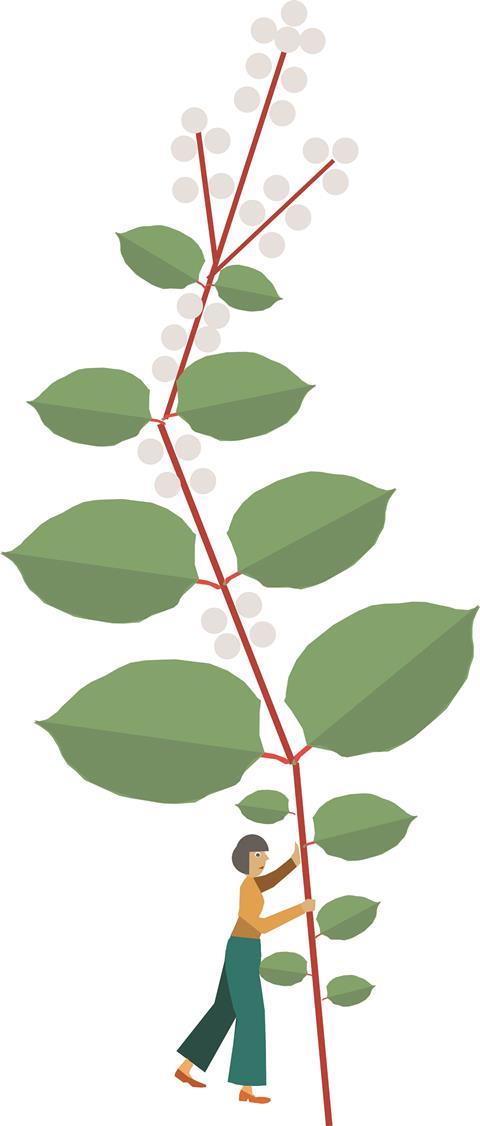Japanese knotweed has been back in the news, following a high-profile Court of Appeal case. Michael Draper and Dan Eastwood provide a back to basics guide, including the options for land- and homeowners with Japanese knotweed on their property
It was perhaps not until John Wyndham’s 1951 novel The Day of the Triffids that plants captured a significant cross-section of the public’s imagination as potentially harmful and destructive.

The fictitious triffid shares characteristics with Japanese knotweed (Fallopia japonica ). Triffids are prolific, worryingly mobile and poisonous. Through its underground rhizomes, Japanese knotweed is equally prolific and mobile, with potentially destructive consequences to land and property – though, fortunately, it is not poisonous.
Unlike the proverbial Gordian knot, cutting Japanese knotweed is to be strongly discouraged. Knotweed is spread by small fragments of rhizome or stem growing or being transported through earth or water and in theory, the air, although it is very rare for airborne seeds to germinate; new plants will grow from fragments in soil or water.
In this article, we look at the law relating to Japanese knotweed, the implications of recent case law, and the practical options for land- and homeowners faced with Japanese knotweed on their property or that of a neighbour.
Background law
‘Japanese knotweed’ is actually a group of invasive plants, known collectively as Japanese knotweed sensu lato (s.l.; in the broader sense) taxa . The other less frequent culprits include dwarf, giant and bohemian (hybrid) knotweeds. All of these species are subject to section 14 of the Wildlife and Countryside Act 1981: they are all referred to in part II of schedule 9 to the act, which states the plants to which section 14 applies.
Section 14(2) provides: ‘Subject to the provisions of this Part, if any person plants or otherwise causes to grow in the wild any plant which is included in Part II of Schedule 9, he shall be guilty of an offence.’
Japanese knotweed offences under this act are enforced by the police and local authority.
It is not currently an offence to simply allow knotweed to grow on your land, as this is not ‘causing’ it to grow in the wild, which implies some positive action. However, actions which cause the spread of Japanese knotweed – such as cutting or strimming knotweed, or depositing it or material contaminated by its rhizome or stem – may constitute an offence under this act.
Knotweed is also classified as ‘controlled waste’ under the Environmental Protection Act 1990 (EPA 1990), and therefore must be disposed of at an appropriately registered or licensed site, and if by a third party, they must be a registered waste carrier. If attempting to treat knotweed, be aware that certain herbicides and waste material resulting from such treatment may also be hazardous waste under the Hazardous Waste (England and Wales) Regulations 2005.
The good news is that, despite stories to the contrary, knotweed cannot grow through an impermeable surface such as concrete. However, it does grow through gaps in such surfaces, which can cause physical damage as the plant grows and expands. The Royal Institution of Chartered Surveyors (RICS) states that Japanese knotweed ‘…can cause damage to property including drains and pipework, patios, paths and drives, boundary and retaining walls, outbuilding, conservatories and gardens. Treatment programmes are both long and expensive and can last up to three years. There is potential for regrowth and [it] can lay dormant for up to 20 years’.
In 2015, the Council of Mortgage Lenders issued the following guidance in connection with its Handbook:
- ‘The presence of Japanese knotweed or other invasive species might affect the valuation of a property and might be an issue for customers whose property is affected, but who find it difficult to afford treatment costs.
- ‘Mortgage lenders will normally require evidence of treatment that will eradicate the plant as a condition of lending if knotweed is present on or near the site of a property.’
Further detailed guidance is contained in part 2 of the UK Finance Mortgage Lenders’ Handbook particular to individual lending institutions.
Complete destruction seems to be the holy grail of Japanese knotweed control
Public perception also plays its part, and the presence of Japanese knotweed may either frustrate a sale or cause a downward negotiation of price – subject always to mortgage finance being available. The presence of knotweed on a property or within seven metres of it (the estimated lateral extent of roots – however, a recent investigation suggest lateral spread is typically 2.5m (Fennell et al, ‘Japanese knotweed (Fallopia japonica): An analysis of capacity to cause structural damage (compared to other plants) and typical rhizome extension’, PeerJ (July 2018)) – either results in some lenders refusing to lend, or in bespoke mortgage offer conditions being stipulated, requiring an insurance-backed treatment and management plan over a number of years – sometimes up to 20 – which significantly increases costs due to professional inspections to confirm management of the knotweed.
In September 2015, RICS published an addendum to its information paper (no longer current, but may be referred to as information), aimed at informing valuers of residential property. It states: ‘5.8.1 As standards develop across the treatment industry, it is likely that lenders will begin to specify that the management plan provider is an “appropriately qualified person or company” such as an accredited member of an industry recognised trade association such as the Property Care Association and the Invasive Non-Native Specialists Association.’
For the reasons noted above, the Law Society introduced a standard question on its preliminary enquires TA6 form under environmental matters relating to the presence of knotweed and any management plan.
Knotweed on neighbouring property: case law
Property could be affected by knotweed growing on neighbouring property, potentially resulting in physical damage or loss of value. This may be caught by the individual policies of some lenders, which require a management plan if the plant is within a certain distance of the property. These plans have a not insignificant cost, and may also have an impact on the value of property.
Recent case law casts some light on this issue.
In Waistell & Williams v Network Rail Infrastructure Ltd [2017] UK CC (February 2017), it was accepted in the county court that the value of the land was reduced by the presence of Japanese knotweed on Network Rail’s land, even if treated, and it was held that Network Rail had breached the duty of care it owed its neighbours to take reasonable steps to minimise a known hazard. The claim for encroachment was not successful, however, as there was no physical damage, so an order requiring work to undertake treatment was refused. However, each claimant recovered damages of:
- £4,320 (the cost of treatment backed by insurance)
- £10,000 and £10,500, respectively, for loss of property value.
In the second case, also at the county court, Adam Smith and Eleanor Smith v Rosemary Line [2018] UK CC (February 2018), the presence of untreated knotweed on the defendant’s land, close to the boundary with the claimants’ land, had the effect of reducing the value of the claimants’ land from £800,000 to £720,000. The judge was prepared to grant an order requiring the defendant to enter into a contract with a reputable contractor to treat the knotweed on her land.
Cutting above-ground biomass can lead to the spread of knotweed, if done incorrectly
County court judgments are not binding authorities, so the Court of Appeal decision in Network Rail Infrastructure Ltd v Williams [2018] EWCA Civ 1514 provides a welcome clarification of the law. The appeal court upheld the county court decision, but for different reasons: a claim in private nuisance is not made out merely because of the diminution in the property’s market value (a claim for pure economic loss); rather, a claim is successful because the encroachment of knotweed rhizomes diminishes the ability to enjoy the amenity and utility of property, as it ‘imposes an immediate burden on the owner of the land in terms of an increased difficulty in the ability to develop, and in the cost of developing, the land’. As noted above, soil containing knotweed rhizomes is controlled waste under the EPA 1990 and must be removed by a registered waste carrier. A claimant therefore can compel treatment through a mandatory injunction even in the absence of physical damage to property, because ‘knotweed can fairly be described as a natural hazard which affects landowners’ ability fully to use and enjoy their property and, in doing so, interferes with the land’s amenity value’.
Another potential avenue, but one as yet untested, are community protection notices issued either by local authorities or the police under the Anti-social Behaviour, Crime and Policing Act 2014. These potentially could be used to control Japanese knotweed if it is having a detrimental effect on the quality of life of others.
Practical measures for control
Land- and homeowners are quite reasonably often confused about the best way to tackle knotweed. Companies offer a range of solutions, from control to eradication, with price tags ranging from several thousand pounds to tens of thousands. As having an appropriate management plan is central to the liability of knotweed spread and could impact on the ability to secure loans on property, the evidence base supporting the use of a given control strategy must be strong and defensible.
Approaches taken to deal with a Japanese knotweed infestation depend on:
- how established the plant is
- the size of the affected area
- the habitat it is found in
- how much money is available for treatment
- what the land will be subsequently used for.
In all instances, specialist contractors should be used to treat the plant and remove any waste, as they will provide an insurance-backed guarantee for the management work done.
Current Environment Agency online guidance suggests herbicide application, burying or burning as control strategies. Other organisations such as RICS, and trade organisations such as the Property Care Association and Invasive Non-Native Specialists Association, also provide guidance documentation for their members. Recent work carried out by Swansea University on the herbicides approved for use on knotweed (Jones et al, ‘Optimising Physiochemical Control of Invasive Japanese Knotweed’, Biological Invasions (August 2018)) highlighted the lack of independently reviewed and appropriately scaled field trials to provide robust evidence to inform best practice. This raises further considerations as to where liability lies if new evidence is presented that calls into question previous best practice guidance. How responsive do guidance providers need to be to such evidence?
The Swansea University trials provided empirical data showing that a single application of glyphosate-based herbicide between August and October gives adequate knotweed control. However, crucially, control is only achieved after multiple years’ application (dependent on how extensive the plant biomass is).
More cost- and labour-intensive strategies, involving injecting individual plants or cutting down the plant before applying herbicide, do not improve control over spraying alone, and some herbicides currently approved to treat knotweed are not effective. Perhaps most importantly for property transactions, it is difficult to prove the plant is dead – the above-ground biomass is gone, but extensive below-ground rhizome, while dormant, may still be viable. Although dormancy may be broken by disturbance, reapplication of herbicide will reinstate dormancy.
Physical treatment methods (such as cutting, covering and burning) are resource-intensive because the plant produces extensive below-ground biomass that is highly resilient, making it difficult to treat all the plant fragments present. Japanese knotweed in its natural habitat is highly resilient to disturbance, and even small fragments of the plant will remain dormant when covered by rock or soil, waiting for favourable conditions to return. Also, cutting above-ground biomass and rhizome fragmentation caused by physical treatments can lead to the spread of knotweed, if done incorrectly.
Eradication – is it necessary?
Eradication – complete destruction – seems to be the holy grail of Japanese knotweed control. Promises are made, with the insinuation that anything less than eradication is substandard. Homebuyers and mortgage companies alike look towards eradication as a guarantee of a knotweed-free future.
Many companies offering ‘eradication’ will actually mean control
There are a range of physical remediation methods aimed at ‘eradicating’ knotweed rhizome. Methods range from excavation with offsite disposal at a licenced landfill site (the costliest) to onsite encapsulation with an impenetrable material (geomembrane) and ‘soil screening’, where knotweed material is picked from a conveyor belt following excavation, and the soil reused onsite. All of these approaches are very expensive, and the large-scale excavation of contaminated material risks not clearing all the plant, and possibly spreading it more widely to other sites. Furthermore, few (if any) have been independently evaluated and had their effectiveness scrutinised publicly.
In addition, it is important to note that many companies offering ‘eradication’ will actually mean control – where the plant is put into dormancy. Few companies will look at rhizome survival under the surface, defining ‘eradication’ or ‘control’ as the lack of above-ground growth over a period of time.
Should eradication mean eradication (established and tested), or is no above-ground growth for many years sufficient for the knotweed to be described as eradicated? Of course, the distinction could be important for legal cases and insurance companies. There is currently confusion among consumers, who are unsure what they are paying for and what they need for their infested land.
More expensive land treatment may be considered for development sites requiring rapid remediation, but the application of these treatments in domestic settings would appear excessive under most circumstances.
Induced dormancy through herbicide treatment should be enough for most land use in a typical domestic setting. A recent report has shown that the extent of rhizome spread is less than previously thought, and the potential damage to property caused by the plant is largely without foundation (see Fennell et al above). As new evidence emerges in relation to the spread and impact of Japanese knotweed, it may mean that current lending requirements and the Court of Appeal decision are not the last word on the matter of this pernicious weed, and we move to a point that we accept that knotweed is lying underground, but that it is controlled.
A final word on keeping property free from Japanese knotweed: do not collect ‘free’ top soil or compost from sources that cannot guarantee that the soil does not contain small fragments of rhizome or stem.
Downloads
Japanese Knotweed addendum pgguidance 2015
PDF, Size 32.07 kb




















